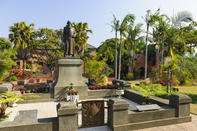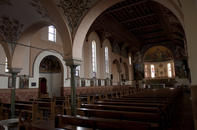Mariannhill Monastery
The Mariannhill Monastery is situated on the outskirts of Pinetown. It was established in 1855 by Austrian monk Father Francis Pfanner after a long search for suitable ground in the region. The first Catholic missionaries that arrived in the Durban area had a hard time finding land for their mission station, as many locals already had strong protestant beliefs.
Eventually, a mission station was built in the hills of Durban, from where the station settlements expanded further into the region, one such being the monastery in Pinetown. The Catholic community grew rapidly in the area, totalling around 285 monks. It held the status of the largest Trappist settlement in the world.
The Mariannhill Monastery was built in the Romanesque Revival style, and the complex still stands today in ‘the valley of the monks’, as the area is known. The complex includes the monastery, a church, workshops and museum, a repository, sisters' convent with vestment department, the Jabulani Self Help Centre, St Francis College and St Joseph's Cathedral. The Monastery Retreat House is open to both religious travellers and people looking for spiritual guidance.
Outdoor Experiences

Pinetown lies close to numerous outdoor picnic spots and nature reserves. The New Germany Nature Reserve is a popular site with locals. It offers an array of activities from game watching, hiking, biking and a hide by the watering hole for birding enthusiasts.
The Pinetown Museum is located in the library complex on the corner of Old Main Road and Crompton Street. The museum focuses on local history and its displays reflect the early history and cultural diversity of this town. It also covers aspects of anthropology and a replica of Mrs Ples is on display next to stone-age tools and artefacts.
Mountain Biking in Pinetown Valley
A range of beautifully manicured trails traverse the 250ha Giba Gorge Bike Park, set within a valley blessed with a distinctive, powdery red soil near Pinetown. There are four trail options to choose from: 10.2 km Orange Route, a 5.2 km Green Route, a 6.7 km Blue Route and finally the 1.2 km Gibe Downhill.
The 7 km-odd Blue Route is the most radical option, running right up against the N3 freeway at its westernmost point. From here, it dips down dangerously to pass through a blue gum plantation. The Mainline has super-smooth flowing lines, tight berms and wooden bridges, while the Free Ride section will undoubtedly improve your riding skills and focus. Being hand-made, the trails allow some tight cornering and all protruding rocks and tree stumps are clearly marked with white paint.

